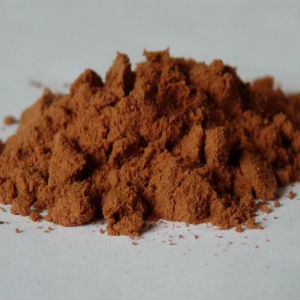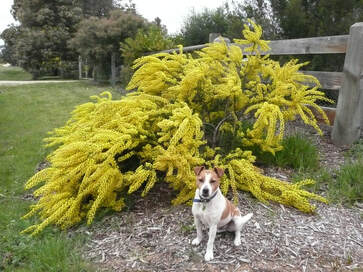Recreating the Country blog |
|
- becoming wild in isolation Golden Wattle, Acacia pycnantha. Commonly pronounced - ‘Pick-nan-tha’  Large golden flowers in spring and shiny green 'leaves' make this local wattle a favourite Large golden flowers in spring and shiny green 'leaves' make this local wattle a favourite Some human context One of our most internationally celebrated wattles is the extraordinary Golden Wattle, Acacia pycnantha. Every Olympic athlete wares the green and gold because of the golden flower clusters and the glossy green 'leaves' adorning this humble small tree. Read why they are not true leaves but phyllodes in my May blog on acacias … and it’s also our national floral emblem? Its claim to super-celebrity status as Australia’s floral emblem is quite dubious in the light of its limited distribution. The Golden Wattle grows naturally in only three states; NSW, Victoria and SA and it’s a declared weed in Tasmania. Oops! The story of making it to celebrity status can be summed up in three words - politics, charisma and money.  Tannin powder harvested from the bark of wattle trees is still used for tanning leather today Tannin powder harvested from the bark of wattle trees is still used for tanning leather today Translating its botanical name helps to appreciate its charismatic charms as pycnantha literally means ‘dense clusters of flowers’ More Greek – pyknos = dense & anthos = flower. It may seem strange to read this now, but it was its commercial value in the early 1900's, as the richest source of natural tannin, that was the game changer. The powerful and influential leather industry in the more established eastern states threw their weight behind its choice. This was enough to sway the members of the ‘National Conference of the Wattle Day League’ in 1913 to recommend the Golden Wattle as the national flower. Though it took another 75 years of debate to have it declared Australia’s floral emblem in 1988. Follow this link to read more about this fascinating history  A short lived small tree that provides important ground layer habitat for wildlife. A short lived small tree that provides important ground layer habitat for wildlife. Nature notes The Golden wattle is a quick growing small tree that will reach its mature height of 5 meters in 3 - 5 years. It produces clusters of pollen rich flowers in winter & spring. This pollen is critical protein rich food for native bees and ants at the end of winter when there is a shortage of food. Beatles, butterflies and wasps find its sap-wood, leaves and seed irresistible as well. In the web of life all these insects are a smorgasbord for the many insectivorous woodland birds. It is relatively short lived (7-12 years), though it is very fast growing and quick to mature. This makes it the perfect pioneer small tree providing early shelter for the slower growing longer lived trees emerging around it. The benefits of a short life Having a short life results in quick establishment of fallen-log habitat in native bush and wider biodiversity plantings. This form of 'on-ground' shelter is critical for reptiles, amphibians, ground feeding birds and small mammals. Its short life also offers other unexpected benefits to the ecology of forests and woodlands. When it falls it disturbs the soil and opens up the overhead canopy letting in more sunlight and warmth. Sunlight, warmth and soil disturbance are necessary to kick-start new life in the form of the seeds of grasses, herbs, shrubs and trees lying dormant in the soil. The nitrogen it has added to the soil with the help of rhizobia will enable these new plants to establish more quickly. Scroll to the end of my May blog on Acacias to read about amazing rhizobia Caution to home gardeners Its short lifespan and medium to large size makes it a poor choice for most home gardens and for narrow farm plantations. Its early demise will open gaps in narrow plantations and likely cause wind damage to adjacent trees and shrubs. In large gardens, wider farm plantations and native bushland its short life becomes a valuable asset to the ecology as mentioned above.  Acacia pycnantha dry pods and seed. Photo from 'Yarnauwi Farm' website Acacia pycnantha dry pods and seed. Photo from 'Yarnauwi Farm' website Propagation The Golden Wattle produces large quantities of edible seed from December to early January. Efficient separation of the seed from the dry pods is made easier by choosing the right harvest time. The best time for seed collection is when the majority of the dry pods have started to open revealing the shiny black seeds inside. Handfuls of pods can then be stripped from the tree onto a tarpaulin spread at the base of the tree. Many of the seeds will separate from the pods when they fall to the ground. A common garden sieve can be used to finish the seed cleaning, Store in zip-lock plastic bags until needed. It is easy to propagate from seed using the boiling water treatment described at the end of the May 2020’s Acacia blog.  Next week I'll introduce a small local wattle with lots of charm though much less international fame. Gold-dust Wattle, Acacia acinacea
2 Comments
8/6/2020 08:56:53 am
Thank you for your marvellous web site. I stumbled upon it with delight this morning because I've been trying to discover for a book I'm writing whether fungi play the same role with eucalypts and Australian native trees that they do on the other side of the equator. Im reading a marvellous book, The Songs of Trees: Stories from Natures's Great Connectors by a lyrical botanist called David George Haskell. I learned there that fungi play a significant role for trees, but he writes only about northern hemisphere varieties. Also, as you can see, I call my website 'wattletales' so - isn't the universe (or maybe just the internet) marvellous.
Reply
Steve
8/6/2020 11:07:46 am
Hi Lindy,
Reply
Leave a Reply. |
Click on the image below to discover 'Recreating the Country' the book.
Stephen Murphy is an author, an ecologist and a nurseryman. He has been a designer of natural landscapes for over 30 years. He loves the bush, supports Landcare and is a volunteer helping to conserve local reserves.
He continues to write about ecology, natural history and sustainable biorich landscape design. 
|


 RSS Feed
RSS Feed
